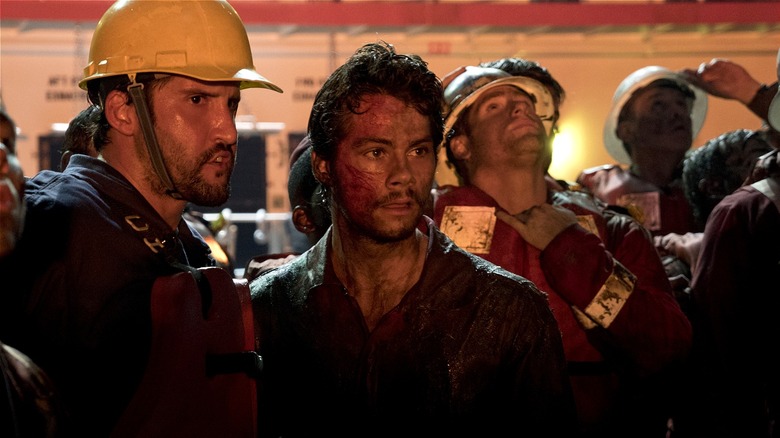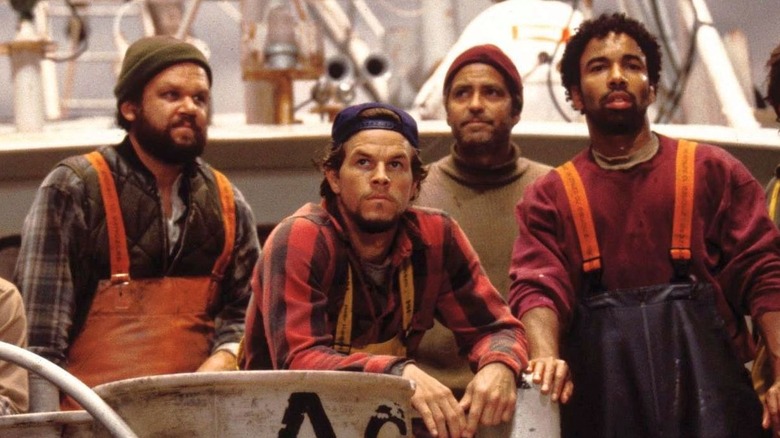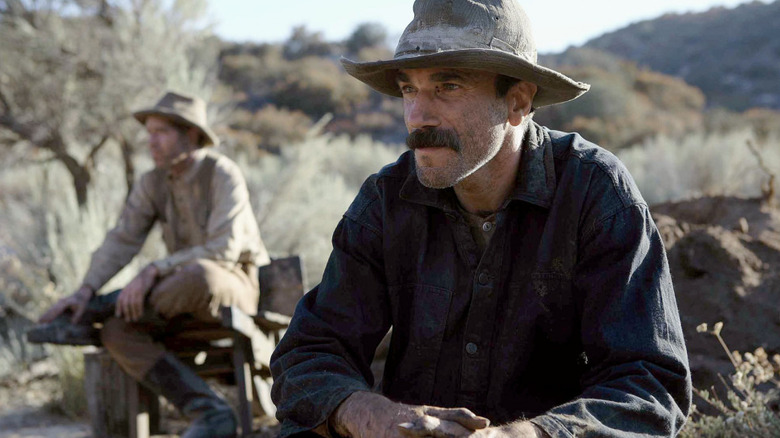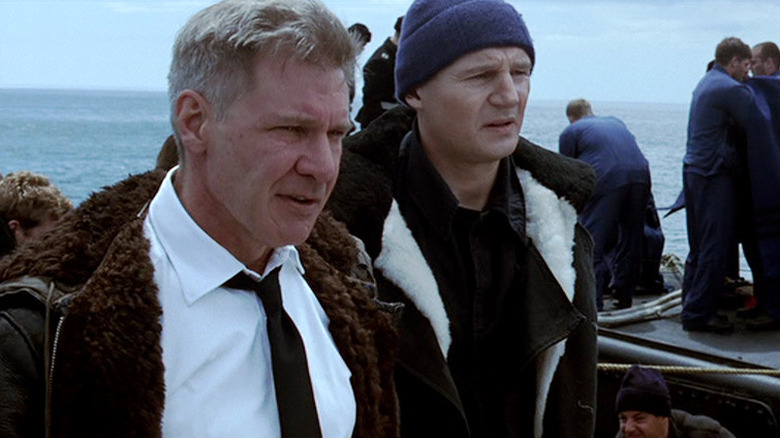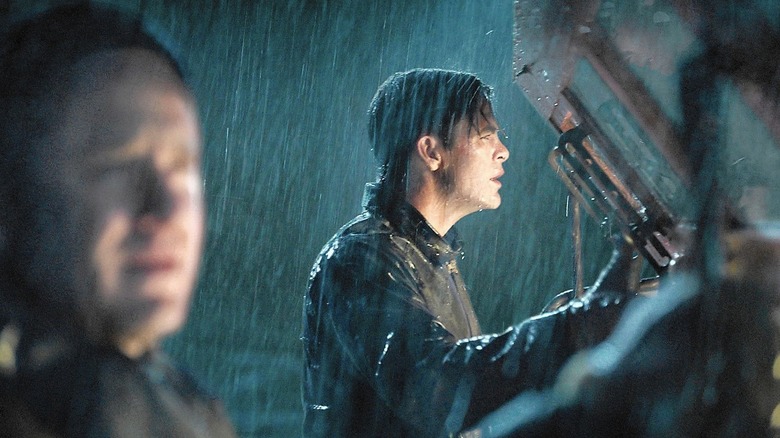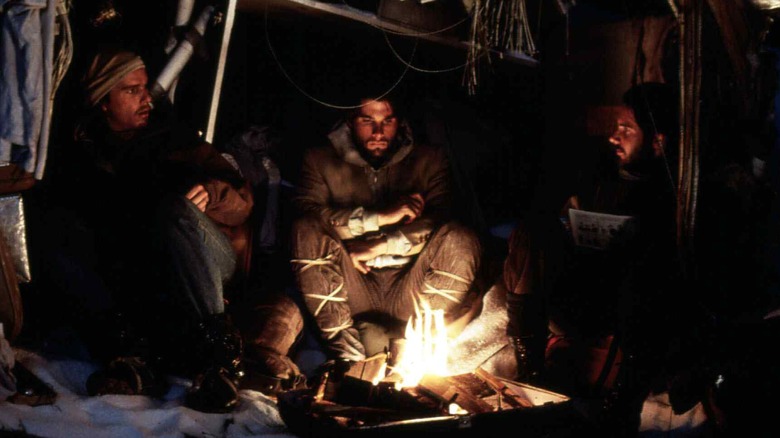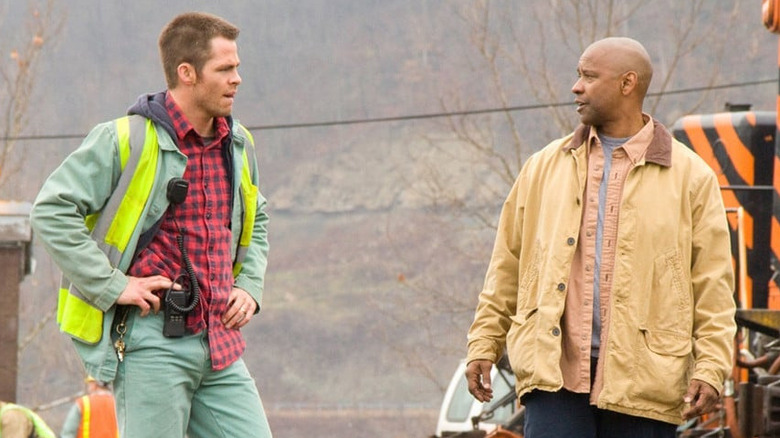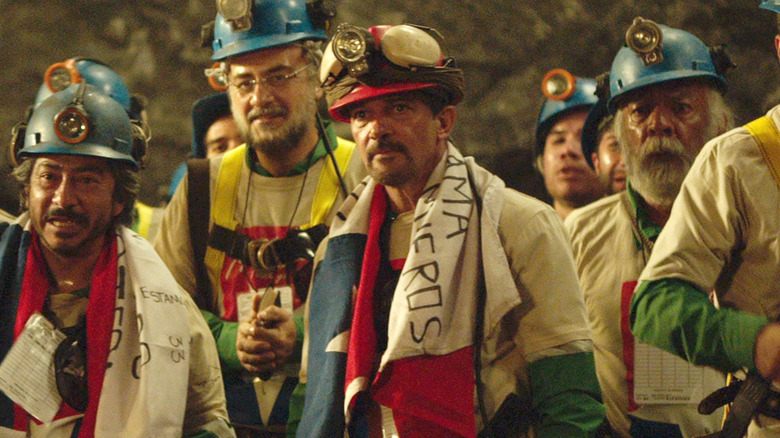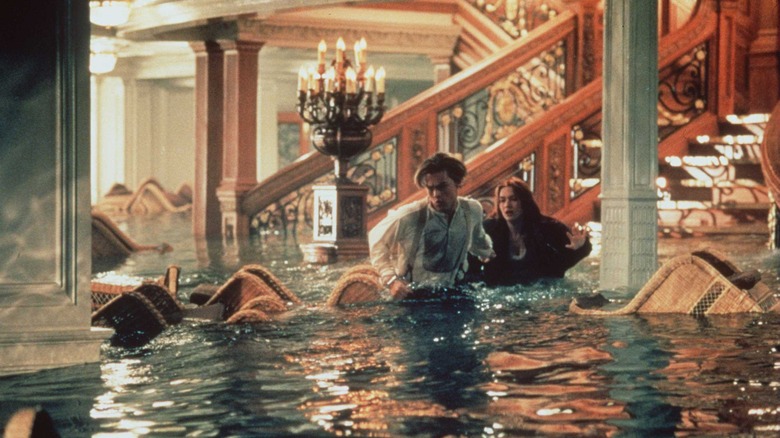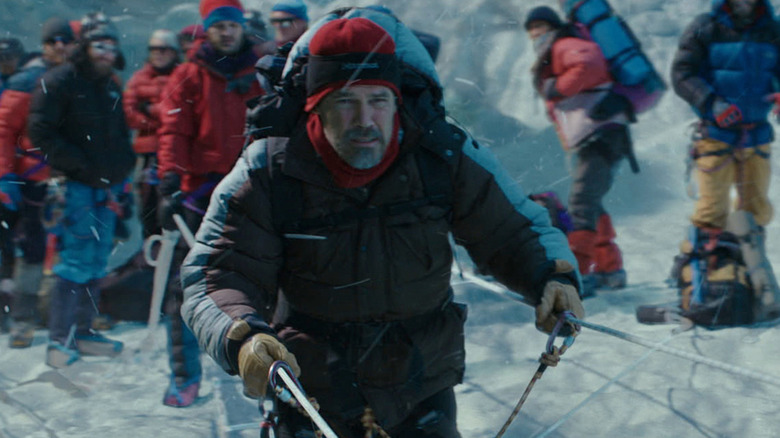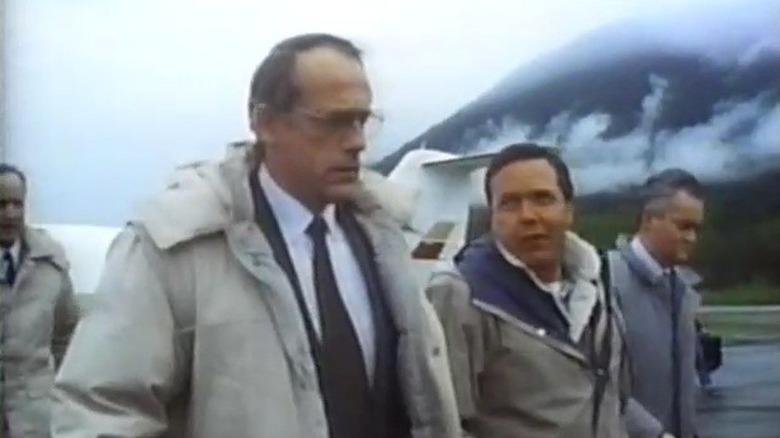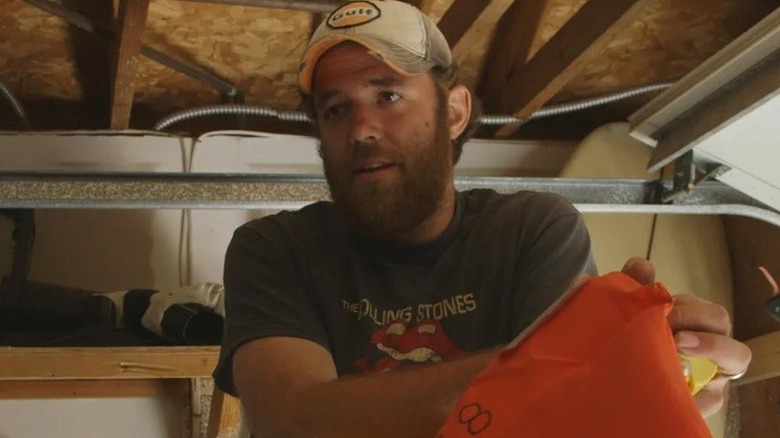In 2010, the Deepwater Horizon oil rig suffered an explosion that resulted in the largest oil spill in history, not to mention one of the biggest environmental disasters the world has ever seen. And that’s to say nothing of the 11 people who died during the initial explosion and its resulting fires. Hollywood didn’t waste much time giving the event the disaster movie treatment, with the film “Deepwater Horizon” following only six years later. Mark Wahlberg, Kurt Russell, Gina Rodriguez, John Malkovich, and Kate Hudson play just a few of the many people who were either working on the rig at the time or on the periphery of the disaster and its aftermath.
“Deepwater Horizon” joins a relatively small subgenre of movies known as biographical disaster films — projects that follow most of the tropes of regular disaster movies, only the disaster in question is one that actually happened. More specifically, biographical disaster films generally feature actors portraying some of the real people involved in the incident, or at least cover specific things that happened as part of it.
There are a few other movies that follow the example of “Deepwater Horizon,” with some even specifically taking place in, on, or near the water. There are also a few movies that use a real disaster as a backdrop, but otherwise are almost entirely fictional in terms of characters and subplots. All those types of movies and more are recommended herein, going beyond just a list of disaster films you need to see before you die and focusing on ones that have a more specific thematic connection to “Deepwater Horizon.”
The Perfect Storm
Did you watch “Deepwater Horizon” and wish that there was another biographical disaster movie about a water-based event that starred Mark Wahlberg? Well, you’re in luck, because “The Perfect Storm” checks those boxes. There are several ways that this movie based on a true story lied to viewers, from the personalities, relationships, and actions of some of the crew members to the use of CGI to amp up the titular storm. But it’s all in the service of making for a more dramatic and entertaining movie. To that end, “The Perfect Storm” succeeds.
In this case, the real-life event in question occurred in 1991, when a fishing boat encountered a cyclone that later absorbed a hurricane to form the so-called perfect storm. The entire crew was killed, and the boat was never recovered. The 2000 movie largely tells the same story, with plenty of creative liberties taken and a heavy dose of special effects put into play — plus the directorial guidance of “Poseidon” helmer Wolfgang Petersen, who certainly knows his way around a big-budget disaster movie spectacle. In addition to Wahlberg, George Clooney, John C. Reilly, William Fichtner, John Hawkes, Mary Elizabeth Mastrantonio, and Diane Lane round out the ensemble that play the crew of the ill-fated Andrea Gail, along with their friends and loved ones.
There Will Be Blood
When ranking every Daniel Day-Lewis movie from worst to best, there is one that easily rises above the rest in terms of the quality of both his performance and the movie itself. 2007’s “There Will Be Blood” is the kind of movie that’s easy to recommend just in general, but it shares a connection to “Deepwater Horizon” in that both are about the oil industry. More specifically, both are about the dangers of oil drilling and the very literal human cost that often comes with extracting petroleum.
That being said, other than protagonist Daniel Plainview (Day-Lewis) being loosely based on early 20th century oil tycoon Edward Doheny, “There Will Be Blood” is an entirely fictional tale. But that shouldn’t be enough to keep it from being follow-up viewing to “Deepwater Horizon,” particularly in the way the former depicts the early days of oil drilling and the latter sees how far the technology has come — although it apparently hasn’t come far enough to prevent casualties from happening in the name of procuring oil. (The more things change…)
It must also be noted that Day-Lewis isn’t the only actor to give an absolutely dynamite performance here, as “There Will Be Blood” is also the movie that made the world first take notice of the true depths of Paul Dano’s talent and range — playing not one but two characters, to boot.
K-19: The Widowmaker
From an oil rig above the water to a submarine beneath it, we come to 2002’s “K-19: The Widowmaker.” The movie tells a fictionalized version of the ill-fated 1961 maiden voyage of a Cold War-era Soviet submarine that is built in an attempt to keep up with the United States’ nuclear submarine program of the time. Unfortunately, the submarine’s development is fast-tracked, and as a result it’s poorly constructed and lacking in multiple key safety features. Needless to say, things don’t bode well for the vessel or its crew as a result.
As it becomes clear that catastrophic failure is inevitable, it’s left up to Captain Alexi Vostrikov (Harrison Ford) to decide if it’s more important to save as many of his crew’s lives as possible or follow his orders no matter the cost. We’ll leave it at that so you have the chance to see what happens yourself. And you should, as “K-19: The Widowmaker” is one of director Kathryn Bigelow’s most unfairly overlooked films, overshadowed by a surprisingly crowded field of submarine movies in the 1990s and early 2000s. This may be an unpopular opinion, but it’s a better movie than “The Hunt for Red October” as far as we’re concerned.
The Finest Hours
Unfortunately, most of the media coverage of “The Finest Hours” focused on what a huge box office bomb it was, with Disney estimated to have taken a $75 million bath on the film. And this was a year when six of the top 10 highest grossing movies were all Disney movies, so it was at a time when the company could seemingly do no wrong. But 2016 was big on superhero movies, “Star Wars,” and animation — so an old-fashioned rescue drama, based on a true story, just wasn’t what moviegoers were looking for in theaters that year.
Which is a shame, because both “The Finest Hours” and the story that it tells are worth your attention. In the 1950s, a U.S. Army tanker encounters a massive storm that causes the vessel to literally split in two. Chris Pine stars as real-life Coast Guard officer Bernie Webber, who leads a small crew that braves the storm on a lifeboat to try and rescue as many of the tanker’s crew as possible. This being a Disney movie, expect a largely triumphant result that smooths over the real story’s rougher edges, but it still suitably celebrates an inspiring moment of heroism that not enough people are aware of.
Alive
Some movies based on real-life disasters focus more on the aftermath of the catastrophe itself. Such is the case for 1993’s “Alive,” which isn’t so much a biographical disaster movie as a biographical survival movie. The incident that sets off the events depicted in the film is a 1972 plane crash carrying a Uruguayan rugby team, some of the team’s staff and family members, and others not affiliated with the team at all — 40 passengers in total, plus the aircraft’s crew.
A fair number of passengers initially survive the crash, but many succumb to their wounds in the days after. Eventually, the remaining survivors run out of food. Desperate to survive, they ponder the unthinkable, and in the off chance you don’t know what that “unthinkable” entails, just proceed with caution as it’s not for those with weak stomachs. Another movie based on the same event, called “Society of the Snow,” hit Netflix in 2023 and is generally considered far superior — and more accurate — than “Alive.” Watch both films, certainly, but the somewhat more commercial “Alive” is the one that might appeal more to “Deepwater Horizon” fans specifically.
Unstoppable (2010)
Not many people realized it at the time of the movie’s 2010 release, but “Unstoppable” was inspired by a true story about a runaway train. The fact that it was director Tony Scott’s final film, and was marketed as a typical Tony Scott action movie — down to the casting of frequent collaborator Denzel Washington in the lead role — meant that the movie’s real-life origins were overlooked. But what’s so impressive about “Unstoppable” is that it works regardless of the filter through which it’s viewed.
The real story already sounds like a Hollywood action blockbuster, but since just reading about something like that isn’t exciting enough, we need a big-budget, high-octane movie version with all the expected bells and whistles. A series of events and operator errors lead to a speeding freight train carrying dangerous materials to travel over 60 miles without an engineer, with multiple high-risk maneuvers enacted to stop it. It might not seem like the type of movie that critics would usually like, but the Rotten Tomatoes critical consensus reads, “As fast, loud, and relentless as the train at the center of the story, ‘Unstoppable’ is perfect popcorn entertainment,” with the film earning a surprisingly high 87% Certified Fresh rating.
The 33
Walking the line between the biographical disaster and biographical survival genres is “The 33,” based on the 2010 mine collapse in Chile that left nearly three dozen miners trapped more than 2,000 feet underground. The workers spent a harrowing 69 days confined in the caved-in mine before they were rescued. Antonio Banderas and Lou Diamond Phillips play two of the trapped miners; James Brolin and Gabriel Byrne are two of the key players in the rescue operation; and Juliette Binoche is the sister of the miner played by Banderas.
It’s an incredibly stacked cast talent-wise, and everyone does stellar work here. In fact, the strong performances of the ensemble go a long way in elevating a movie that is admittedly a bit too formulaic in its approach — a disappointment given the uniqueness of the situation being depicted. But formulaic doesn’t mean bad by any stretch, and even if the story deserved a less by-the-numbers movie, “The 33” still belongs on the watchlists of all fans of this type of film.
The Command
Originally known as “Kursk,” but released in the United States as “The Command,” this 2018 biographical disaster film is about a Russian nuclear submarine that sank in 2000. As a desperate rescue mission is undertaken to extract the submarine’s crew before their limited air supply runs out, the operation has to overcome various political hurdles and other forms of legal red tape as it is caught between the bureaucracy of multiple nations.
In the final film released before his death, Max von Sydow plays Admiral Vitaly Petrenko, the movie’s stand-in for Russian president Vladimir Putin. And so it goes for most of the key players in the movie, renamed either to avoid controversy or simply to allow for more creative freedom in the story. One of the only exceptions is United Kingdom Royal Navy Commodore David Russell, played by Colin Firth, who continues to insist on helping to rescue the submarine’s crew despite multiple refusals from Russia. Russia does finally agree to swallow its pride and accept outside help in saving the crew — but the question becomes whether it does so in time.
Titanic
While 1997’s “Titanic” plays fast and loose with a lot of the facts of the ship’s infamous sinking and has scenes that make no sense, it nonetheless accomplishes its goal of being a crowd-pleasing epic based on a very real disaster. And it doesn’t seem possible to recommend movies that are even remotely related to nautical disasters — real or otherwise — without throwing James Cameron’s record-breaking epic into that pool as well.
There really was a ship called the Titanic, it really did hit an iceberg, and it really did go down in a horrific catastrophe in which roughly 1,500 people died — including a highly disproportionate amount of the third class passengers. Beyond that, the characters of Jack (Leonardo DiCaprio) and Rose (Kate Winslet) were James Cameron inventions, as the writer-director wanted there to be an equally epic love story to serve as the centerpiece of the epic disaster. Not that we need to explain or sell you on “Titanic,” but again, it would have been disingenuous not to include it here.
Everest
Here’s another movie about people trying to survive a disaster on top of a dangerous, snowy mountain. But in the case of 2015’s “Everest,” what separates it from “Alive” is that the people at the center of the event chose to be there. In 1996, a group of climbers are trekking along the tallest (above sea level) mountain in the world when they encounter an especially nasty blizzard. Even though they’re experienced climbers who are prepared for the harsh conditions of the mountain, it’s the kind of blizzard that’s impossible to prepare for — and difficult to survive.
In an especially impressive showing of dedication to make “Everest” realistic, at least 20 actual people who were either among the climbers, were relatives of the climbers, or were otherwise associated with the expedition in some way are represented in the movie under their real names. Playing them are heavy hitters that include Josh Brolin, Robin Wright, John Hawkes, Keira Knightley, Jake Gyllenhaal, Vanessa Kirby, and Emily Watson, to name a few. Reviews had particular praise for the cinematography, which came as close to replicating the feeling of being in a blizzard on Everest as one can get short of actually being there.
Dead Ahead: The Exxon Valdez Disaster
Though many people automatically associate made-for-TV movies with generic Hallmark holiday films and cheesy Lifetime “ripped from the headlines” fare, there are plenty of TV movies that are actually worth watching. Among those is “Dead Ahead: The Exxon Valdez Disaster,” which aired on HBO in 1992 and chronicled what was probably the most well-known oil spill disaster of all time before Deepwater Horizon happened. It needs to be mentioned that “Dead Ahead” isn’t easy to watch these days, currently unavailable to stream and only available to buy via pricey secondhand VHS copies.
But it’s worth putting on the watchlists of the handful of streamers that have pages for it, so that you can be notified and check it out if it ever does pop back up again. It was well-received at the time and won several awards, and despite it obviously showing its age, it still remains an incredibly compelling fictionalized story of the aftermath of the 1989 spill, covering both the rush to clean it up and the battle over who should take the blame for it. More specifically, it’s also about how that battle had a significant impact on the speed and effectiveness of the containment and cleanup, ultimately making it much worse than it needed to be.
The Great Invisible
Once you’ve watched the Hollywood version, it stands to reason that you should also watch a documentary about the Deepwater Horizon incident in order to directly hear from the people involved and get a more accurate picture of what happened. There are several such documentaries, from feature-length efforts to episodes of larger docuseries and everything in between. But the best, most expansive, and most readily available of all of them is easily 2014’s “The Great Invisible.”
Anyone who watched “Deepwater Horizon” and found themselves wanting to learn as much about the incident as possible should of course see everything there is on the subject. But “The Great Invisible” rises above the rest in large part because it focuses more directly on the human toll the incident took — not just those directly involved and their loved ones, but the many other people who also ended up being negatively affected by it in one way or another. Its director, Margaret Brown, is more famous for her 2022 Netflix documentary “Descendant,” but “The Great Invisible” remains her most ambitious work, and sees her tackle her biggest subject.

